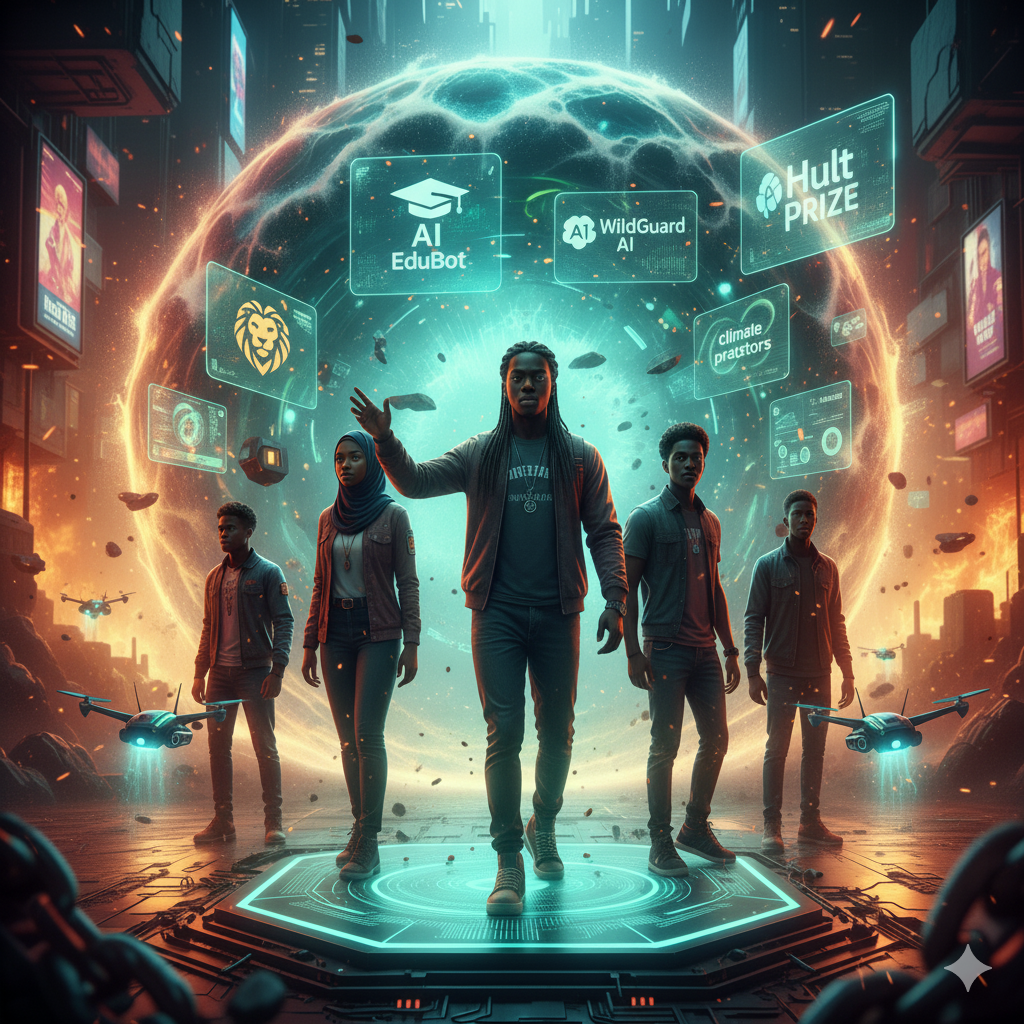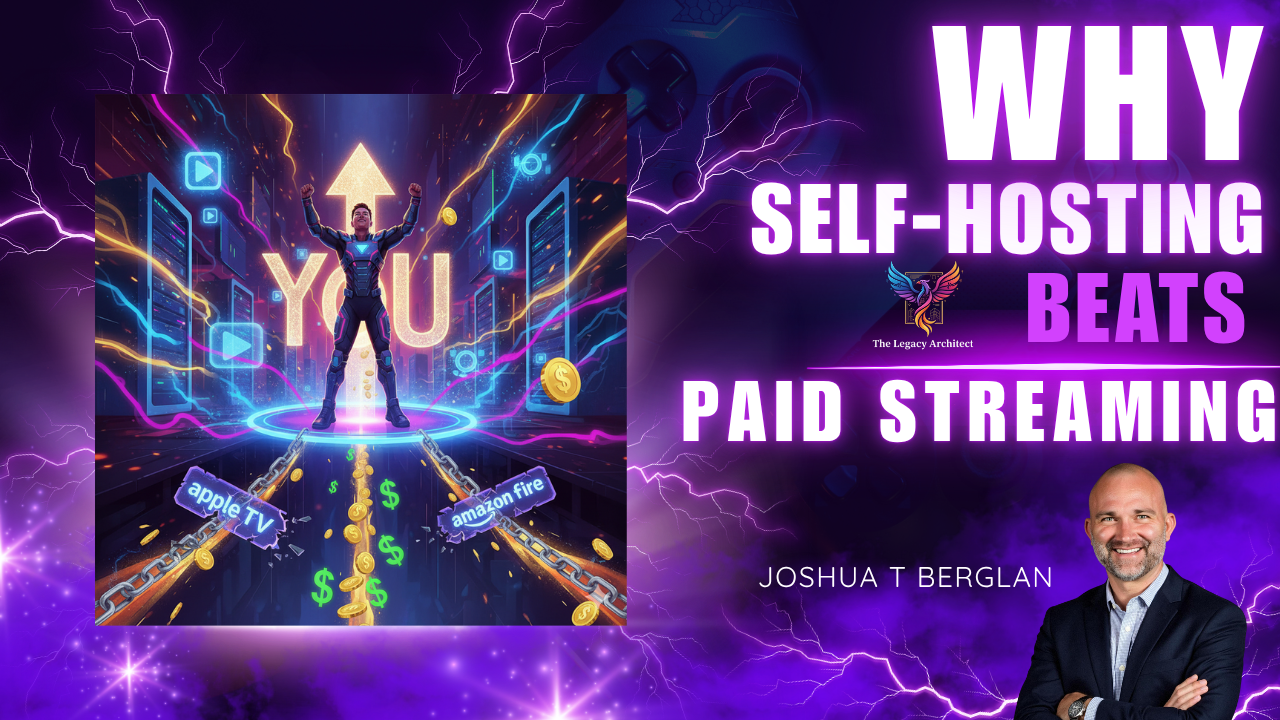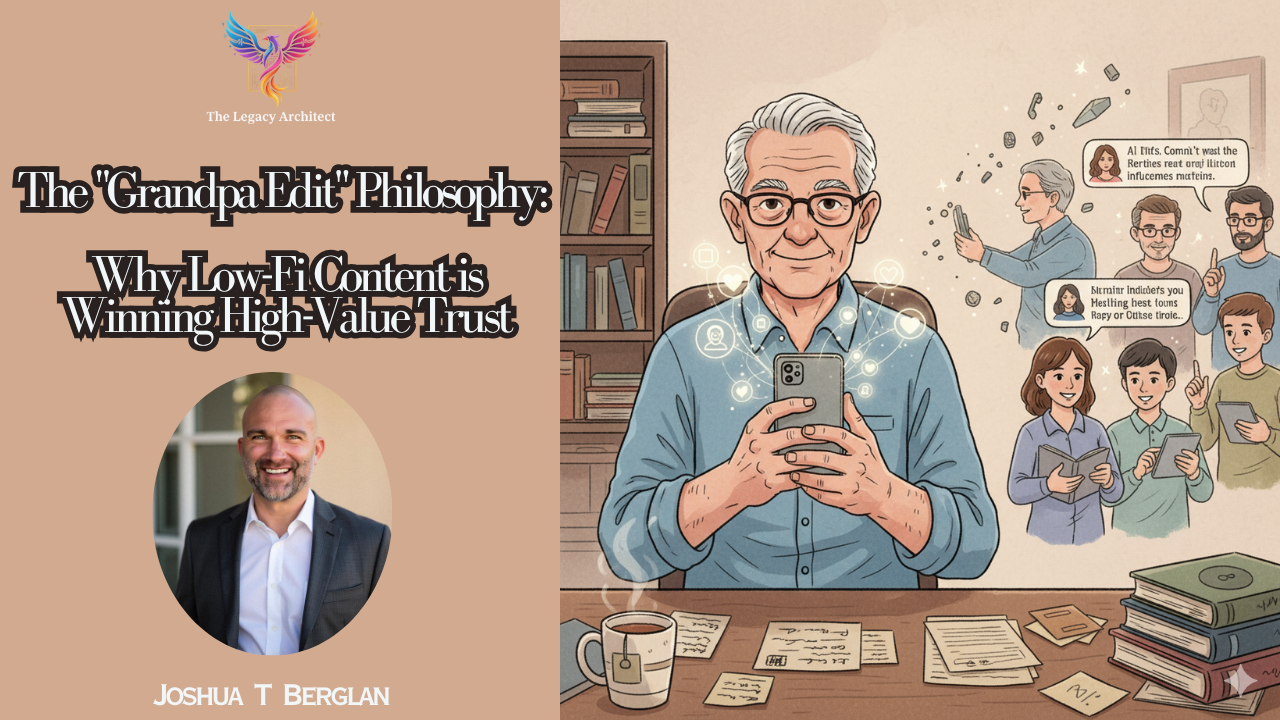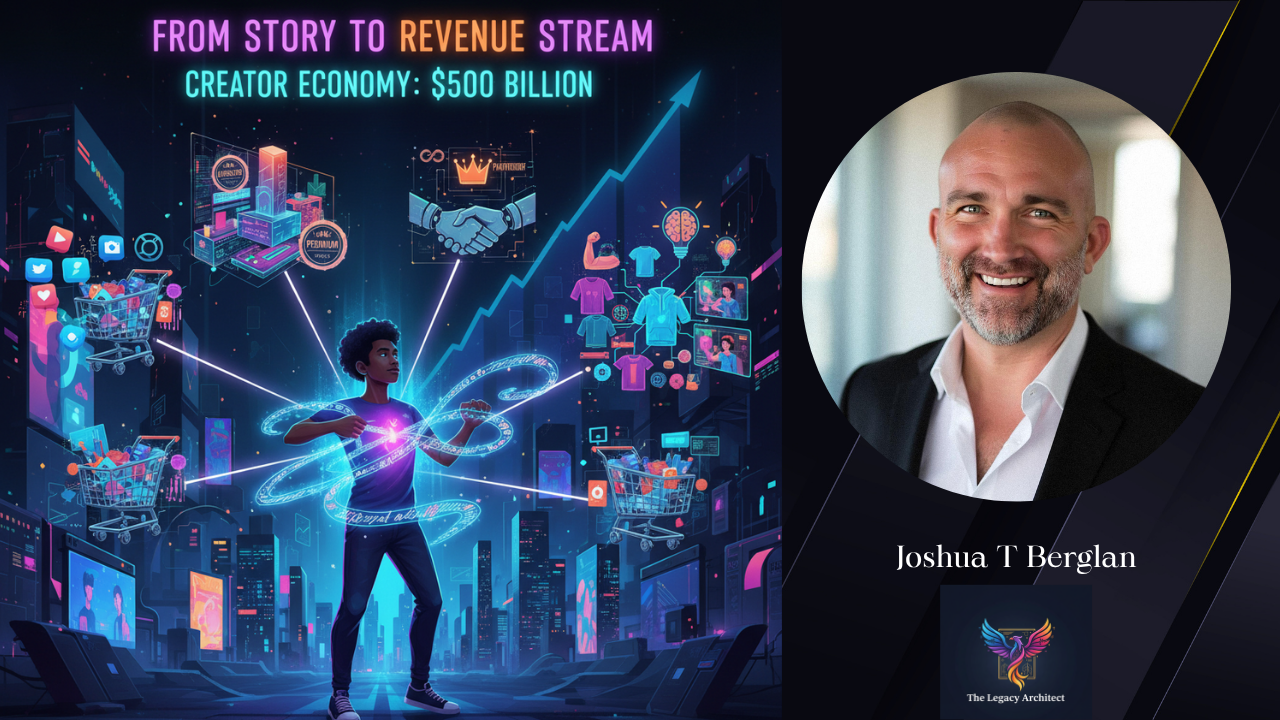
The Legacy Architect Dispatch
An exclusive from The World's Mayor Experience, published by The Legacy Architect, Joshua T. Berglan.
Your source for transformative content that dives deep into personal growth, authentic branding, and overcoming adversity. Explore powerful insights on storytelling, mental resilience, and building a meaningful legacy in the a digital age, curated to educate, inform, and inspire your journey.
Elevating Outcomes through Eddy's Generative AI and ESTREAM: Advancing Academic Success and Student Empowerment
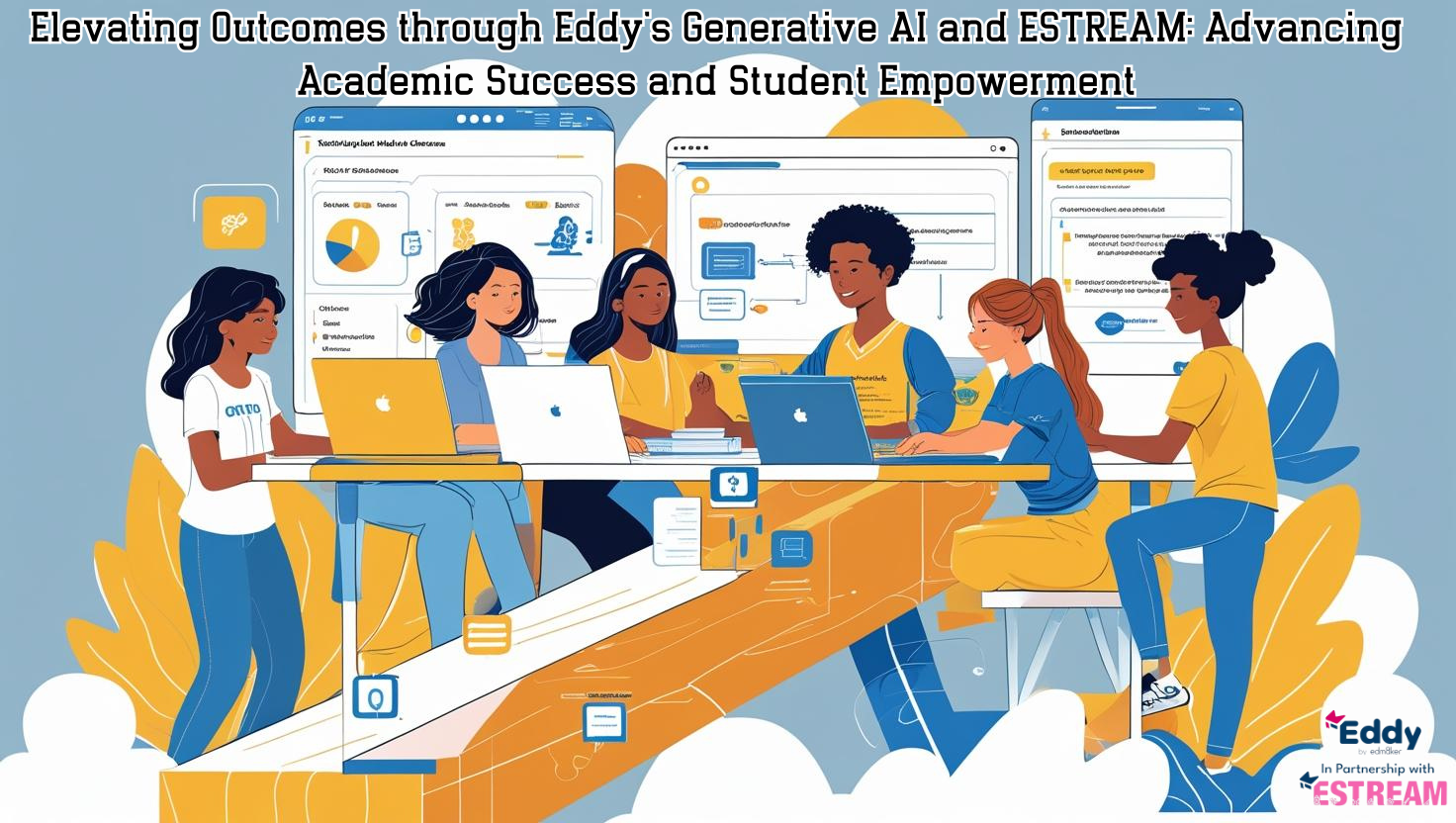
Elevating Outcomes through Eddy's Generative AI and ESTREAM: Advancing Academic Success and Student Empowerment
By Dr. Rehana Lynda Mohamed Ed.D. & Terence Tan Ed.M.
Abstract
This study investigates the profound impact of the Entrepreneurship Studies, Science, Technology, Research, Engineering, Arts, and Mathematics (ESTREAM) curriculum, significantly enhanced by the Eddy Generative AI Curriculum Assistant, on student proficiency in reading and mathematics at St. Anthony School of Higher Education. This K-12 institution serves a predominantly low-socioeconomic student population. Employing a mixed-methods, project-based learning (PBL) approach, facilitated by Eddy's ability to create standards-aligned PBL lessons, we analyzed student performance data in both reading and mathematics across all grade levels. The results reveal statistically significant gains in reading scores and substantial positive growth in mathematics proficiency following ESTREAM's implementation. The interdisciplinary and engaging nature of ESTREAM, coupled with Eddy's seamless integration of project-based learning, is identified as a critical factor that contributes to enhanced student engagement, problem-solving, and critical thinking, driving this dual academic success. This research underscores the potential of integrated curricula, supported by advanced AI tools like Eddy, to effectively address foundational academic skills and offers valuable implications for educators serving diverse student populations.
Keywords
ESTREAM curriculum, reading proficiency, mathematics proficiency, Generative AI Curriculum Assistant, interdisciplinary learning, project-based learning, low-socioeconomic students, improvement in student engagement, academic growth.
Introduction
Literacy and numeracy are the bedrock of academic achievement, serving as crucial foundations for future learning, diverse career paths, and active participation in society. The ability to read with comprehension, write effectively, and reason mathematically is indispensable for successfully navigating the complexities of the 21st century. However, the development of these core skills is not uniform across all student populations, particularly for students with different learning needs and those from low-socioeconomic backgrounds. These disparities often result in significant achievement gaps that hinder academic progression and limit future opportunities for these vulnerable student groups. Understanding the multifaceted factors contributing to these gaps is thus essential for designing effective educational interventions.
Students from disadvantaged socioeconomic contexts often face significant barriers, including limited access to educational resources, inadequate support systems, and diminished exposure to print-rich environments and early numeracy experiences. Concurrently, students with diverse learning needs encounter inherent challenges in information processing, working memory, executive function, and specific academic skills, all of which directly impede foundational literacy and numeracy acquisition. These compounding factors contribute to a pervasive achievement gap that can widen considerably over time if not addressed through targeted and effective educational interventions. Failure to effectively address these deeply entrenched disparities simultaneously exacerbates educational inequity and profoundly impacts individual life outcomes and broader societal development.
Students with learning difficulties frequently encounter distinct obstacles in acquiring foundational literacy and numeracy skills, manifesting as challenges in information processing, working memory, executive function, and specific academic proficiencies, such as phonological awareness or number sense. These intrinsic learning variations necessitate the implementation of targeted and highly differentiated educational approaches, particularly considering that variations in experiential learning can significantly influence the neurobiological underpinnings of reading development (Taylor et al., 2023). Consequently, effective pedagogical interventions must address identified skill deficits while concurrently accounting for the neurodevelopmental and experiential factors that shape individual learning trajectories, thereby ensuring more equitable educational outcomes for these learners.
Student literacy and numeracy represent the fundamental pillars of academic achievement and are indispensable foundations for future learning, diverse career trajectories, and meaningful societal engagement. The ability to read with comprehension, write effectively, and reason mathematically is indispensable for successfully navigating the complexities of the 21st century. Therefore, the implementation of effective educational strategies is imperative to bridge the persistent achievement disparities within these foundational domains (Cabral-Gouveia et al., 2023). Students exhibiting diverse learning needs and those originating from low socioeconomic backgrounds often commence their schooling with reduced exposure to rich vocabulary, print-dense environments, and foundational numeracy experiences, which can precipitate an achievement disparity that may substantially widen over time if not proactively remediated. Effectively addressing these multifaceted challenges therefore necessitates a comprehensive and enduring commitment to educational equity, which, in turn, mandates innovative pedagogical approaches capable of accommodating diverse learning needs and ameliorating the profound effects of socioeconomic disadvantage.
Background
St. Anthony School of Higher Education, a private K-12 institution, serves a diverse student population that includes learners from low socioeconomic backgrounds and those with varied pedagogical needs. The institution demonstrates an unwavering commitment to addressing unique challenges while simultaneously maximizing the distinct opportunities inherent within its diverse student demographic. This commitment to delivering high-quality education and cultivating equitable outcomes therefore necessitated a strategic pursuit of highly innovative and empirically effective pedagogical approaches. This strategic endeavor focused on establishing dynamic learning environments designed to transcend conventional methodologies, thereby ensuring that every student could fully actualize their academic and personal potential. Leveraging the Eddy Generative AI Curriculum Assistant (Eddy, 2025), a sophisticated tool meticulously tailored to align with the ESTREAM framework developed by Mohamed (2024), a comprehensive, year-long curriculum was precisely engineered to fulfill these evolving pedagogical demands.
The ESTREAM curriculum (Mohamed, 2024) represents a marked divergence from conventional, compartmentalized pedagogical approaches, championing instead a holistic, integrated, and applied learning philosophy dedicated to maximizing student success. Intentionally designed to transcend didactic content transmission, it is meticulously structured to cultivate vital 21st-century competencies, including critical thinking, complex problem-solving, collaborative teamwork, and innovative creativity, skills indispensable for all learners to flourish. By deeply immersing students in authentic, real-world challenges and creating engaging collaborative projects, this curriculum effectively prepares students for rigorous academic pursuits and comprehensively equips them for the dynamic demands of future careers and active, engaged citizenship. This immersive pedagogical framework offers particular advantages for students from underserved or low socioeconomic backgrounds by providing access to rich experiential learning opportunities that might otherwise be inaccessible, while simultaneously revitalizing the engagement of previously disengaged learners through enhanced practical relevance and sustained active participation.
Tangible Gains in Math and Reading Proficiency
Within the dynamically evolving landscape of education, innovative pedagogical approaches are paramount for cultivating holistically developed learners equipped with indispensable 21st-century competencies. The scalable implementation of the ESTREAM curriculum (Mohamed, 2024) at St. Anthony’s, facilitated by the Eddy Generative AI (Eddy, 2025), has demonstrated remarkable potential for elevating student proficiency in foundational subjects, including mathematics and reading, concurrent with a discernible enhancement in confidence and engagement. Specifically, the generative AI capabilities of Eddy empower educators to dynamically design interactive, project-based lessons, meticulously aligned with the ESTREAM curricular framework and prevailing state standards, that seamlessly integrate the essential technological competencies required for future success. This technologically integrated and consistently delivered PBL methodology comprehensively addresses the multifaceted needs of a diverse contemporary learner population, thereby creating deeper conceptual understanding and practical knowledge application. This approach equips students to master rigorous academic content while simultaneously cultivating the critical agility and adaptability indispensable for lifelong success within a dynamically evolving global landscape.
The present study was conducted at St. Anthony School of Higher Education, a private K-12 institution serving a diverse student population, notably including a significant proportion of learners from low-socioeconomic backgrounds and those exhibiting varied learning needs. Throughout the Academic Year 2024–2025, the ESTREAM curriculum (Mohamed, 2024) was meticulously implemented across five distinct classrooms, providing each participating K-12 student with approximately 1,080 hours of curricular engagement. Integral to the successful operationalization of ESTREAM within these diverse pedagogical settings was the strategic leveraging of Eddy, a generative AI curriculum assistant (Eddy, 2025). Eddy is pretrained on the foundational ESTREAM curricular framework and further refined by its founder, resulting in PBL lessons that directly align with the ESTREAM framework while remaining meticulously standards-aligned. By harnessing Generative AI to produce detailed lesson sequences, targeted formative assessments, and comprehensive interdisciplinary project prompts, Eddy thus empowered educators to deliver the complete ESTREAM sequence with unparalleled consistency and fidelity across all grade bands, thereby underscoring its pivotal role in amplifying the curriculum's reach and impact.
This study utilized a rigorous mixed-methods approach to comprehensively evaluate the efficacy of the ESTREAM curriculum across the 2024-2025 academic year (AY). Specifically, quantitative analysis of student performance data spanning the K-12 spectrum was triangulated with rich qualitative insights gleaned from student and educator interviews. The research specifically investigated the impact of ESTREAM, conceptualized as a PBL framework, on student performance within two critical foundational domains essential for academic success and lifelong learning: reading and mathematics (Mohamed, 2024). End-of-year (EOY) assessment data in both subjects were rigorously analyzed through a comparative approach, contrasting baseline and EOY scores for 53 of the 61 participating students. For reading, the assessment encompassed key domains including phonological awareness, phonics, high-frequency word recognition, vocabulary acquisition, and both literature and informational text comprehension skills. Concurrently, mathematics assessments evaluated student proficiencies in number operations, algebraic reasoning, measurement, data analysis, and geometrical concepts across all participating grade levels.
The implementation of the ESTREAM curriculum by Mohamed (2024) has yielded statistically significant improvements in reading comprehension and substantial positive growth in mathematical proficiency. The interdisciplinary and project-based nature of ESTREAM creates an enriched learning environment that directly contributes to these observed academic advancements. By exposing students to a diverse array of authentic texts and discipline-specific terminology across scientific, technological, engineering, artistic, and mathematical domains, ESTREAM strategically expands their academic vocabulary and augments critical reading comprehension beyond conventional language arts instruction. In mathematics, students have demonstrated robust progress toward grade-level proficiency, evidencing a notable upward mobility of students from lower performance strata to mid- or above-grade level tiers. Eddy (Eddy, 2025) is instrumental in this success, consistently generating PBL lessons that meticulously align with the ESTREAM framework and prevailing educational standards. This AI-powered pedagogical assistance empowers educators to proficiently deliver the comprehensive ESTREAM sequence, thereby ensuring learners receive holistic and precisely targeted instruction that culminates in measurable academic growth. The underlying premise of this inquiry posits that the integrated ESTREAM curriculum, designed to cultivate cohesive, interdisciplinary learning experiences through the explicit development of critical thinking, creative problem-solving, and collaborative skills, is instrumental in enhancing student proficiencies across these academic domains. Consequently, the empirical findings of this study are anticipated to contribute substantially to the broader academic discourse on effective educational practices for diverse student populations, particularly those confronting socioeconomic disadvantages, by offering empirical insights into the transformative potential of integrated curricula to build foundational academic skills and advance equitable learning outcomes.
Significant Growth
The findings delineate statistically significant improvements in student academic achievement in both reading and mathematics following the adoption of the ESTREAM curriculum (Mohamed, 2024). These substantial gains were consistently observed across all proficiency tiers, underscoring the curriculum's robust capacity to effectively address the diverse learning requirements of the student demographic. A pivotal factor contributing to these enhancements was the marked increase in student engagement, significantly facilitated by the interactive, PBL lessons dynamically generated by the Eddy GenAI Curriculum Assistant (Eddy, 2025). This immersive pedagogical approach, coupled with the cultivation of robust problem-solving competencies and advanced critical thinking capacities, suggests that the ESTREAM framework, powerfully supported by Eddy's targeted assistance, cultivated a more dynamic and effective learning environment, culminating in measurable improvements in both mathematical understanding and practical application.
Reading
Analysis of reading assessment data from St. Anthony's School of Higher Education (K-12) reveals encouraging progress in reducing the number of students performing below grade level. A slight decrease was observed in the "One Grade Level Below" category, moving from 14 to 12 students. More significant improvement was seen in the "Two Grade Levels Below" category, which decreased from 23 to 19 students. Most notably, a substantial positive shift occurred in the "Three+ Grade Levels Below" category, with the number of students in this lowest proficiency group dramatically decreasing from 13 to just 2 students. This data indicates a positive trend in addressing reading deficits and effectively moving students towards higher levels of proficiency across the school.
Three+ Grade Levels Below
Two Grade Levels Below
One Grade Level Below
In conclusion, the demonstrable and statistically significant improvements in reading proficiency observed at St. Anthony School of Higher Education subsequent to the implementation of the ESTREAM curriculum (Mohamed, 2024) are largely attributable to the curriculum's inherently interdisciplinary and project-based pedagogical framework. This framework actively cultivated enhanced reading comprehension, robust vocabulary acquisition, and sophisticated critical analysis of textual information. Furthermore, the integration of qualitative student data provides deeper insights into ESTREAM's transformative impact on student engagement and the evolution of instructional practices. Key factors identified as contributing to this success, namely, increased student engagement, enhanced problem-solving proficiencies, and the cultivation of critical thinking abilities, collectively underscore ESTREAM's profound potential to advance holistic literacy development.
Math
The 2024–2025 mathematics performance data at St. Anthony’s School of Higher Education reveals substantial positive shifts in student achievement due to the ESTREAM curriculum (Mohamed, 2024). A significant reduction in students performing substantially below grade level is evident, with 23 fewer students in the "Three+ Grade Levels Below" category. Concurrently, there was a considerable increase in students meeting or exceeding benchmarks, with the "Mid or Above Grade Level" cohort surging from 0 to 13 students, and the "Early On Grade Level" group more than quadrupling. This overall trend indicates a positive impact on student mathematical understanding and the effectiveness of targeted interventions.
Individual grade-level analysis further highlights areas of significant success. Grade 11 demonstrated the most substantial gain, with seven students achieving grade-level proficiency, while Grades 8 through 10 collectively contributed nine students to the "On or Above Grade Level" cohort. Kindergarten and Grade 9 achieved 100% proficiency by the end of the year, pointing to strong foundational instruction and effective support. To sustain this growth, recommendations include in-depth analysis of successful instructional practices in high-growth grades, continued targeted support for struggling students, ongoing monitoring, and the sharing of best practices across faculty.
Three+ Grade Levels Below
Mid or Above Grade Level
The data reveals a significant positive shift in addressing critical learning gaps in mathematics. This is evidenced by a substantial decrease in the number of students performing three or more grade levels below expectations, dropping from 26 to 14 students. This remarkable reduction highlights the effectiveness of ESTREAM instructional strategies (Mohamed, 2024) in providing targeted support to students who previously faced the most significant academic challenges. This progress not only signifies a successful effort in moving students out of the lowest proficiency band but also represents a crucial step toward enhancing overall mathematics achievement within the educational setting.
Conversely, the number of students performing one and two grade levels below remained relatively stable. While the significant decrease in the "Three+ Grade Levels Below" category is encouraging, the stability in the "One and Two Grade Levels Below" groups suggests that while students are progressing upwards, many still require targeted support to reach full grade-level proficiency. This highlights the ongoing need for differentiated instruction and potentially more intensive interventions for students who are making progress but have not yet closed the achievement gap. Continued focus on these students will be essential to ensure they continue on a trajectory towards meeting grade-level expectations.
Building Confidence and Deepening Engagement
Beyond quantifiable academic scores, the holistic approach of the ESTREAM curriculum (Mohamed, 2024), significantly amplified by Eddy's targeted support (Eddy, 2025), profoundly impacts student confidence and engagement. The curriculum is meticulously designed to enhance problem-solving and critical thinking skills through active participation and immersive, hands-on experiences. The interactive and captivating pedagogical methods facilitated by ESTREAM and Eddy cultivate a demonstrably greater interest and excitement in Science, Technology, Engineering, and Mathematics (STEM) fields. This heightened enthusiasm, in turn, intrinsically boosts students' motivation, promoting a stronger work ethic and a deeper commitment to their learning journey.
Qualitative insights from student feedback robustly illuminated the profound impact of the Eddy-integrated ESTREAM curriculum (Mohamed, 2024) on learner engagement, particularly among the diverse population of students from low socioeconomic backgrounds and those with varied learning needs. These rich qualitative data, complementing quantitative performance metrics, provided a deeper understanding of how the curriculum's design effectively captivated student interest and promoted active participation. Explicitly, the PBL framework, significantly enhanced by Eddy's generative AI capabilities (Eddy, 2025), cultivated an environment where sustained motivation and intellectual curiosity flourished. For students from low socioeconomic backgrounds, the curriculum's emphasis on hands-on, real-world application, often leveraging accessible digital tools, served to bridge experiential gaps and made learning immediately relevant. Concurrently, for students with diverse learning needs, Eddy's adaptive support and the interactive nature of the lessons facilitated deeper comprehension and provided varied pathways for engagement, effectively mitigating traditional barriers to participation and promoting a more inclusive learning experience. This enhanced engagement is thus critical for promoting academic resilience and cultivating a genuine enthusiasm for learning across all student demographics.
"Animaker and Machine Learning"
"I enjoyed Genially, Animaker, MegaMinds, CoSpace."
"Genially and learning about all the different ways to prompt my AIs."
"My favorite platform is Megaminds... but I learned how to create a video [with] Animaker."
When queried regarding their preferred Eddy/ESTREAM activities (Eddy, 2025) that facilitated new technological learning, a substantial proportion of students conveyed enthusiasm for activities involving programming and artificial intelligence. One student enthusiastically reported liking "Machine Learning," explaining, "I liked programing my machine to detect my fractions." Another highlighted the innovative application of AI in geometry, stating, "The tessellation lesson. I was able to prompt my AI to generate galaxy images that focused on all the shapes, lines, line segments, rays, and angles that was required for my lesson."
The highly interactive and creative nature inherent in various digital platforms emerged as a potent motivator, with students frequently identifying tools such as Genially, Animaker, MegaMinds, and CoSpace as particularly engaging. The intrinsic appeal of generative AI further extended to opportunities for creative expression, as exemplified by one student's remark: "Genially and leaning about all the different ways to prompt my AIs." The immersive and interactive pedagogical elements proved exceptionally engaging, as articulated by another student: "My favorite ESTREAM activity was most def megamind I love how we could build characters and interact with others as well and if we didn’t know an answer we had a trusty side kick ready to teach us about it." Other highly favored digital tools included MegaMinds and PencilCode, alongside DelightX, which one student valued "because of the stuff inside of my own space," collectively underscoring the profound value of personalized and adaptable learning environments.
The practical application inherent in PBL resonated profoundly with learners, developing a sense of autonomy and direct relevance to their interests. For instance, one student observed that PBL "lets students explore topics of interest and see how technology achieves their goals," directly connecting inquiry-based learning with tangible outcomes. Similarly, another student described a "grocery store lesson" as challenging yet highly rewarding, specifically noting its efficacy in teaching "a lot (and patience also)." These examples highlight how PBL facilitates the mastery of complex concepts through real-world engagement, simultaneously cultivating essential transversal skills such as problem-solving, resilience, and critical application of knowledge. By integrating technology seamlessly into authentic tasks, PBL empowers students to develop innovative solutions, bridging the gap between theoretical understanding and practical implementation, thereby preparing them comprehensively for future academic and professional endeavors.
"I hated learning and book work and paperwork until my teacher introduced me to the ESTREAM curriculum and all the activities to make my learning fun and enjoyable and engaging."
Most notably, the ESTREAM curriculum's (Mohamed, 2024) design proved profoundly transformative for learners who had previously exhibited disengagement from conventional pedagogical methods. This pedagogical shift was powerfully underscored by one student's testimonial: "I hated learning and book work and paperwork until my teacher introduced me to the ESTREAM curriculum and all the activities to make my learning fun and enjoyable and engaging." This highlights ESTREAM's capacity to reignite the intrinsic motivation among historically disengaged learners. While overall student enthusiasm for ESTREAM activities was remarkably high, as evidenced by several students indicating "none" or "everything was interesting and fun" when asked about least engaging activities, certain subtle preferences surfaced. For instance, some learners reported finding "Canva was boring after being introduced to Genially" or "the activities we had to do on Canva was boring to me after I saw what I can do on Genially," indicating a distinct preference for more advanced or generative digital tools once exposed to their capabilities. Another student observed, "Animaker, sometimes it’s get complicated," suggesting that perceived complexity in certain tools could temporarily diminish engagement for specific learners.
This comprehensive qualitative feedback, gathered from a diverse student body, conclusively demonstrates Eddy's capability to seamlessly integrate cutting-edge, engaging technologies within the PBL framework (Eddy, 2025). This integration successfully transformed abstract learning into an intrinsically engaging and personally relevant experience. Such an approach significantly boosted student motivation and sustained engagement and participation, consequently providing accessible and stimulating learning pathways that particularly benefited students from low socioeconomic backgrounds and those with diverse learning needs. The heterogeneity of student responses further underscores the criticality of diverse technological tools in accommodating individual learning styles and preferences, an aspect effectively facilitated by Eddy's adaptable curriculum generation capabilities.
This heightened engagement, intrinsically amplified by Eddy's capacity to facilitate exploration with cutting-edge digital tools, consequently cultivates a more robust work ethic and a profound commitment to their ongoing learning journey. By encouraging a resilient growth mindset and empowering students to experience tangible success through challenging yet scaffolded tasks within highly interactive learning environments, the program equips them to cultivate robust self-efficacy and effectively overcome initial perceptions of difficulty in STEM disciplines. Learners consistently develop a profound sense of accomplishment as they successfully complete complex projects and adeptly navigate intricate challenges, which, in turn, solidifies their belief in their capabilities and enhances their intrinsic resilience. Ultimately, the synergistic impact of the ESTREAM curriculum (Mohamed, 2024) and the Eddy AI curriculum assistant (Eddy, 2025) is poised to create a truly transformative learning experience, demonstrating that integrated, highly engaging, and technologically enriched education serves as a powerful catalyst for comprehensive student achievement and holistic personal growth.
Conclusion
In conclusion, the implementation of the ESTREAM curriculum (Mohamed, 2024), profoundly enhanced by the Eddy Generative AI Curriculum Assistant (Eddy, 2025), presents a compelling pedagogical model for institutions seeking to elevate academic outcomes and deepen student engagement, particularly within underserved socioeconomic communities and for learners exhibiting diverse educational needs. The foundational importance of literacy and numeracy for academic success and future life and career opportunities is undeniable; yet, persistent achievement gaps, exacerbated by socioeconomic disparities and inherent learning differences, necessitate innovative and targeted interventions. Within this critical context, the integrated, PBL framework of ESTREAM, powered by Eddy's dynamic capabilities, emerges as an exceptionally effective and responsive solution. This comprehensive curriculum simultaneously addresses core academic demands and cultivates essential 21st-century competencies, thereby directly preparing students for lifelong success and active, informed citizenship.
The ESTREAM curriculum (Mohamed, 2024), strategically engineered to transcend conventional, compartmentalized instruction via an integrated, PBL paradigm, inherently addresses the aforementioned educational challenges. Pivotal to this success are the generative AI capabilities of Eddy (Eddy, 2025), which meticulously auto-generate standards-aligned lessons, interdisciplinary prompts, and robust formative assessments. This functionality ensures unparalleled consistency and fidelity in curriculum delivery across all grade levels, simultaneously integrating essential 21st-century technological competencies, thereby rendering learning highly relevant and dynamic. Such a technologically integrated and consistently implemented pedagogical approach optimizes the student learning experience, developing deeper conceptual understanding and practical application of knowledge that extends beyond conventional classroom boundaries.
The outcomes of this initiative are demonstrably tangible and impactful. The study revealed statistically significant advancements in student mathematics and reading achievement, underscoring ESTREAM's (Mohamed, 2024) proven capacity to drive measurable academic growth across diverse proficiency tiers. Beyond these critical quantitative gains, qualitative feedback gathered from the student population, particularly from learners in economically disadvantaged backgrounds and those with diverse learning needs, reveals a profound increase in both academic confidence and overall engagement. Learners articulated genuine enthusiasm for Eddy (Eddy, 2025) integrated digital tools, such as Animaker, Genially, and MegaMinds, frequently citing the innovative nature of AI interaction and the immediate applicability of their learning within authentic, real-world projects. This heightened enthusiasm created a more robust work ethic and a deeper commitment to continuous learning, thereby proving transformative for even previously disengaged students by rendering education intrinsically enjoyable, engaging, and personally relevant.
Therefore, the synergistic efficacy of the ESTREAM curriculum (Mohamed, 2024) and the Eddy AI assistant (Eddy, 2025) provides compelling evidence that integrated, technologically-augmented, and highly engaging educational frameworks are important and indispensable. This comprehensive model effectively bridges existing experiential gaps, delivers adaptive personalized support, and cultivates vital 21st-century competencies, thereby positioning it as an exemplary solution for educational institutions committed to developing equitable academic success and empowering all learners to thrive amidst the complexities of the 21st century. By establishing a dynamic learning ecosystem where pedagogical innovation seamlessly aligns with individual student needs, this approach effectively mitigates persistent educational disparities and fundamentally prepares learners for navigating and meaningfully contributing to a rapidly evolving global landscape.
References
Cabral-Gouveia, C., Menezes, I., & Neves, T. (2023). Educational strategies to reduce the achievement gap: A systematic review. Frontiers in Education, 8 , Article 1155741. https://doi.org/10.3389/feduc.2023.1155741
Eddy. (2025). Eddy Builder - the Educator's Buddy [Computer software]. Retrieved from app.eddy4teachers.com
Mohamed, R. L. (2024). ESTREAM curriculum (Registration Number TXu 2-447-634). U.S. Copyright Office.
Taylor, E. K., Abdurokhmonova, G., & Romeo, R. R. (2023). Socioeconomic status and reading development: Moving from "deficit" to "adaptation" in neurobiological models of experience-dependent learning. Mind, Brain, and Education, 17 (4), 324–333. https://doi.org/10.1111/mbe.12351






